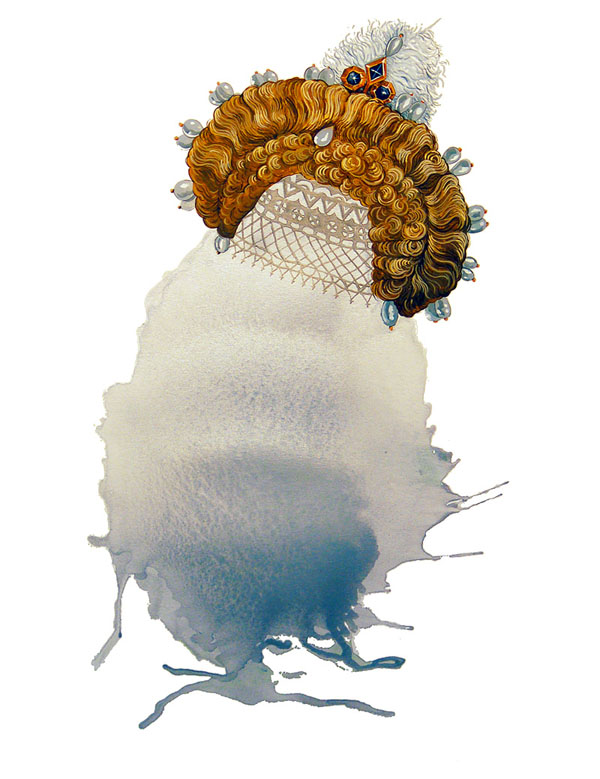 UNLIVED HISTORIES
October 3 – October 28, 2012
Curated by Lauren Turner
While skepticism towards the historical record is not specific to contemporary society, today’s information age does allow for an unparalleled transfer of information that enables an increased engagement with these issues. Digitized archives, open-source materials, and specialized supply vendors enable casual users to acquire specific information and resources regarding their interests. Lauren Adams is able to track and incorporate the Elizabethan imagery that she explores in her Lost Colony Project, often in specialized media like mass-produced fans or custom-printed fabrics.
UNLIVED HISTORIES examines artists using the idea of history, as opposed to specific historic events, as inspiration. Artists include: Lauren F. Adams, Keliy Anderson-Staley, Edward Bateman, Amelia Bauer, Eric Beltz, Jen Blazina, Scott Campbell, Noah Doely, Danielle Durchasiag, Anna Fidler, Sebastian Martorana, Lori Nix, Randy Regier, Adam C. Ryder, Christopher Schneberger, Derek Toomes, Frohawk Two Feathers and Roger Wood.]]>
UNLIVED HISTORIES
October 3 – October 28, 2012
Curated by Lauren Turner
While skepticism towards the historical record is not specific to contemporary society, today’s information age does allow for an unparalleled transfer of information that enables an increased engagement with these issues. Digitized archives, open-source materials, and specialized supply vendors enable casual users to acquire specific information and resources regarding their interests. Lauren Adams is able to track and incorporate the Elizabethan imagery that she explores in her Lost Colony Project, often in specialized media like mass-produced fans or custom-printed fabrics.
UNLIVED HISTORIES examines artists using the idea of history, as opposed to specific historic events, as inspiration. Artists include: Lauren F. Adams, Keliy Anderson-Staley, Edward Bateman, Amelia Bauer, Eric Beltz, Jen Blazina, Scott Campbell, Noah Doely, Danielle Durchasiag, Anna Fidler, Sebastian Martorana, Lori Nix, Randy Regier, Adam C. Ryder, Christopher Schneberger, Derek Toomes, Frohawk Two Feathers and Roger Wood.]]>
News
CAMSTL Satellite Project at Expo Chicago/2012
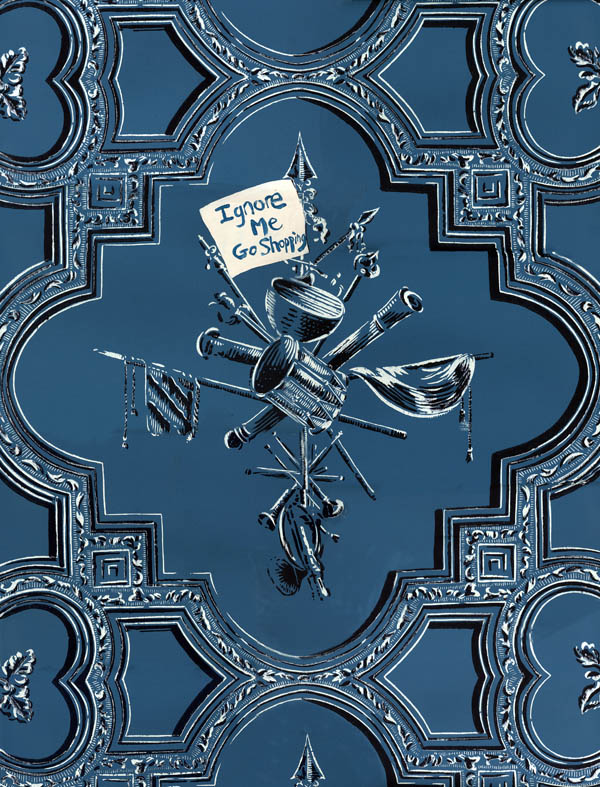 WE THE PEOPLE, a new solo project for Expo Chicago/2012 at the Navy Pier, September 19 – 24, 2012.
Lauren Adams: We the People is organized by the Contemporary Art Museum St. Louis (CAM) and curated by Kelly Shindler, Assistant Curator.
Lauren Adams’s work addresses historical issues of colonialism—the system by which the people of one territory establish systems of authority or control over people in another territory—and industrialization to demonstrate how they inform our present-day reality. Working in a variety of media from painting and drawing to textiles and printmaking, she repurposes centuries-old imagery to explore the relationship between labor and the production of material goods. Adams uses specific images, symbols, and situations from these histories to suggest how they play a significant role in the balance of power between social classes, nations, and ethnicities today.
We the People is an interactive installation in which the artist has painted slogans from recent Occupy Wall Street and Tea Party protests into reproduced Revolutionary War-era wallpaper. The pattern, entitled “General Samuel McClellan,” features a repeated image of various everyday objects from the 18th-century. Extracted and abstracted from its original context, the protest language visible on the wallpaper functions as a generalized call to action. Visitors to CAM’s booth can record their own “protest” on a unique ceramic plate to be displayed during the fair. A custom-designed tea towel made exclusively for Expo Chicago both advertises the project and is exchanged with visitors in return for their contributions.
Adams is also exhibiting new work in a solo exhibition, Hoard, in CAM’s Front Room gallery from September 7 – October 14, 2012 (3750 Washington Blvd., St. Louis, MO 63108).
Above text by Kelly Shindler
READ the EXPO Chicago recap by Chief Curator Dominic Molon.
SEE reviews and exhibition photography at these website links:
Artslant, by Sarah Hamilton
New City Chicago, by Pedro Velez
Hyperallergic, by Philip A. Hartigan
World Socialist Web Site, by Jeff Lusanne
Univision Chicago (photo)
Art in America, The Scene (photo)
Special thanks to Jake Peterson + Arsenal Studios, Bryan Reckamp (tea towel designer), Clare Britt (install and photography), Eli Samuels (install crew), Kelly Shindler and Dominic Molon and the rest of the staff at CAMSTL including David Smith (install crew), as well as Spoonflower.]]>
WE THE PEOPLE, a new solo project for Expo Chicago/2012 at the Navy Pier, September 19 – 24, 2012.
Lauren Adams: We the People is organized by the Contemporary Art Museum St. Louis (CAM) and curated by Kelly Shindler, Assistant Curator.
Lauren Adams’s work addresses historical issues of colonialism—the system by which the people of one territory establish systems of authority or control over people in another territory—and industrialization to demonstrate how they inform our present-day reality. Working in a variety of media from painting and drawing to textiles and printmaking, she repurposes centuries-old imagery to explore the relationship between labor and the production of material goods. Adams uses specific images, symbols, and situations from these histories to suggest how they play a significant role in the balance of power between social classes, nations, and ethnicities today.
We the People is an interactive installation in which the artist has painted slogans from recent Occupy Wall Street and Tea Party protests into reproduced Revolutionary War-era wallpaper. The pattern, entitled “General Samuel McClellan,” features a repeated image of various everyday objects from the 18th-century. Extracted and abstracted from its original context, the protest language visible on the wallpaper functions as a generalized call to action. Visitors to CAM’s booth can record their own “protest” on a unique ceramic plate to be displayed during the fair. A custom-designed tea towel made exclusively for Expo Chicago both advertises the project and is exchanged with visitors in return for their contributions.
Adams is also exhibiting new work in a solo exhibition, Hoard, in CAM’s Front Room gallery from September 7 – October 14, 2012 (3750 Washington Blvd., St. Louis, MO 63108).
Above text by Kelly Shindler
READ the EXPO Chicago recap by Chief Curator Dominic Molon.
SEE reviews and exhibition photography at these website links:
Artslant, by Sarah Hamilton
New City Chicago, by Pedro Velez
Hyperallergic, by Philip A. Hartigan
World Socialist Web Site, by Jeff Lusanne
Univision Chicago (photo)
Art in America, The Scene (photo)
Special thanks to Jake Peterson + Arsenal Studios, Bryan Reckamp (tea towel designer), Clare Britt (install and photography), Eli Samuels (install crew), Kelly Shindler and Dominic Molon and the rest of the staff at CAMSTL including David Smith (install crew), as well as Spoonflower.]]>
Hoard, Solo Exhibition at Front Room, Contemporary Art Museum, St. Louis
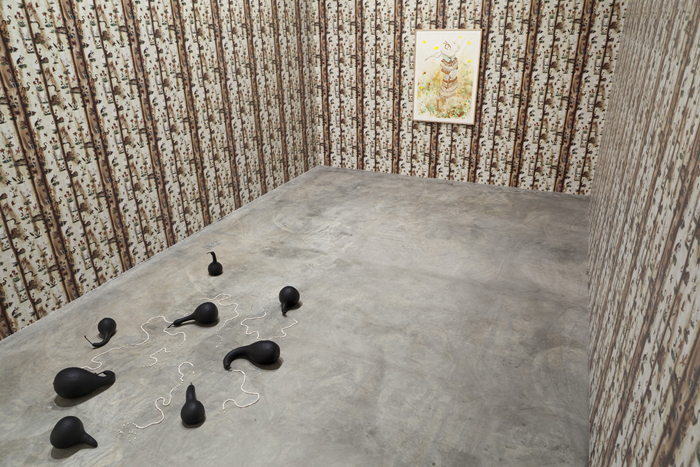 Hoard at CAMSTL, opening September 7 and ongoing through October 14, 2012.
Curated by Kelly Shindler
Mentioned in Temporary Art Review by Laura Barone in an article about Leslie Hewitt’s concurrent show at CAM, Sudden Glare of the Sun.
Lauren Adams: Hoard
Lauren Adams mines the histories of early exploration, colonialism, and industrialization to make new and surprising connections to contemporary sociopolitical issues. Employing a variety of media from paintings and drawings to textiles and printmaking, she engages obscure imagery and phenomena to explore the relationship between labor and material culture. Purposely anachronistic, her objects and installations are also deeply relevant for suggesting how we understand power dynamics today.
In the Front Room, Adams presents a multi-part installation that furthers her research into early encounters between the leaders of Elizabethan England and the North American “New World” in the late 16th and early 17th centuries. On the walls of the gallery, she has installed custom wallpaper titled Spectacle of Hardwick Hall (2012). Drawn by hand and reproduced digitally, the design features symbols found in the large portrait of Queen Elizabeth I (1533-1603) that hangs in the 16th-century Hardwick Hall estate in Derbyshire, England. In the painting (c. 1592; attributed to Nicholas Hilliard, 1547-1619), the queen wears an unusual, voluminous gown embroidered with images of flora and fauna native to the English colonies as well as imagined creatures, such as serpents and monsters. Demonstrating the breadth and depth of her power, the queen’s costume literally contains a world within it. This bringing together of the foreign with the fantastical suggests an exoticization of the colonies as a sensuous albeit perilous “other.” Adams’s translation of this imagery into a repetitive wallpaper pattern calls attention to their peculiarity while neutralizing their potency as royal propaganda.
Also featured in the installation is a large gouache painting titled The Lost Colony (2012). Whereas Spectacle of Hardwick Hall isolates a particular feature of Elizabeth’s dress as a commentary on the riches of empire, this painting conflates the aesthetics and behavior of occupier and occupied. Adams has painted an image of a dancing Algonquin Indian, which she modeled on a 16th century print by Theodor de Bry (1528-1598) that was inspired by John White’s (c. 1540-1593) watercolors of Algonquin Indians in Adams’s home state of North Carolina. The male figure wears a feather headdress and assumes an active pose, brandishing an arrow in hand. His elongated body is adorned with layers of various Elizabethan-era collars of various textures and styles. These have the effect of appearing to civilize, feminize, and also constrict the figure, literally strangling him in fashion. In effect, the painting hybridizes signifiers from both cultures, illustrating the ultimately unsustainable relationships between British and Native American peoples.
The final component of the installation is Bad Seed (2012), an arrangement of hollowed-out, painted-black gourds, interspersed with several strands of freshwater pearls on the gallery floor. Indigenous to the New World as sustenance, here the gourds assume an ornamental function in the same way that pumpkins and Indian corn have evolved from bumper crops to autumnal ornaments. Adams treats the pearls in a similarly inverse manner to producing wallpaper from the pattern of Queen Elizabeth’s gown; both gestures reduce luxurious high fashion to interior decoration. On a deeper level, the stark contrast between the black gourds and the white pearls references the charged racial and ethnic dynamics instantiated in the New World and that have persisted throughout American history.
The title of the exhibition, “Hoard,” refers to the aggregation of wealth and resources by the colonizers of the New World as well as the larger notion of creating an iconographic taxonomy of empire. Through Adams’s appropriation and transformation of colonial imagery — originally intended to denote power and grandeur — into decorative, often fabricated designs, Hoard demonstrates the deterioration of meaning that can accompany the accumulation of things — or, in the case of pre-colonial America, that of people and places as well. Adams collages these abstracted elements together, creating charged absurdities that reflect centuries of inequity. Simultaneously visually alluring and symbolically complex, the works in Hoard remind us how the legacies of the New World’s founding remain both embedded and contested in everyday life.
Adams will present related work in a satellite solo exhibition, We the People, at the inaugural ExpoChicago art fair from September 19-23, 2012. Navy Pier, 600 East Grand Avenue, Chicago, IL, 60611.
Lauren Adams (American, b. 1979) lives and works in Baltimore, Maryland, where she is a full-time faculty member at the Maryland Institute College of Art. She has had recent solo exhibitions at Back Lane West, Cornwall, UK (2012); Conner Contemporary, Washington, D.C. (2011); Luminary Center for the Arts, St. Louis (2011); and Royal NoneSuch Gallery, Oakland, California (2010). Her work has been featured in group exhibitions including: Nymans House and Gardens, Sussex, UL (2012); Cameron Art Museum, Wilmington, North Carolina (2012), Southeastern Center for Contemporary Art, Winston-Salem, North Carolina (2011); Purdue University, Indiana (2011); St. Cecelia’s, Brooklyn, New York (2010); CUE Foundation, New York (2008); Mattress Factory, Pittsburgh, PA (2008); and the Andy Warhol Museum of Art, Pittsburgh, PA (2005); among many others. She received her MFA from Carnegie Mellon University (2007) and has attended several artist residencies, including the Cité Internationale des Arts, Paris (2010); Skowhegan School of Painting and Sculpture (2009); and the Jentel Artist Residency Program, Banner, Wyoming (2008).
–Above text by Kelly Shindler]]>
Hoard at CAMSTL, opening September 7 and ongoing through October 14, 2012.
Curated by Kelly Shindler
Mentioned in Temporary Art Review by Laura Barone in an article about Leslie Hewitt’s concurrent show at CAM, Sudden Glare of the Sun.
Lauren Adams: Hoard
Lauren Adams mines the histories of early exploration, colonialism, and industrialization to make new and surprising connections to contemporary sociopolitical issues. Employing a variety of media from paintings and drawings to textiles and printmaking, she engages obscure imagery and phenomena to explore the relationship between labor and material culture. Purposely anachronistic, her objects and installations are also deeply relevant for suggesting how we understand power dynamics today.
In the Front Room, Adams presents a multi-part installation that furthers her research into early encounters between the leaders of Elizabethan England and the North American “New World” in the late 16th and early 17th centuries. On the walls of the gallery, she has installed custom wallpaper titled Spectacle of Hardwick Hall (2012). Drawn by hand and reproduced digitally, the design features symbols found in the large portrait of Queen Elizabeth I (1533-1603) that hangs in the 16th-century Hardwick Hall estate in Derbyshire, England. In the painting (c. 1592; attributed to Nicholas Hilliard, 1547-1619), the queen wears an unusual, voluminous gown embroidered with images of flora and fauna native to the English colonies as well as imagined creatures, such as serpents and monsters. Demonstrating the breadth and depth of her power, the queen’s costume literally contains a world within it. This bringing together of the foreign with the fantastical suggests an exoticization of the colonies as a sensuous albeit perilous “other.” Adams’s translation of this imagery into a repetitive wallpaper pattern calls attention to their peculiarity while neutralizing their potency as royal propaganda.
Also featured in the installation is a large gouache painting titled The Lost Colony (2012). Whereas Spectacle of Hardwick Hall isolates a particular feature of Elizabeth’s dress as a commentary on the riches of empire, this painting conflates the aesthetics and behavior of occupier and occupied. Adams has painted an image of a dancing Algonquin Indian, which she modeled on a 16th century print by Theodor de Bry (1528-1598) that was inspired by John White’s (c. 1540-1593) watercolors of Algonquin Indians in Adams’s home state of North Carolina. The male figure wears a feather headdress and assumes an active pose, brandishing an arrow in hand. His elongated body is adorned with layers of various Elizabethan-era collars of various textures and styles. These have the effect of appearing to civilize, feminize, and also constrict the figure, literally strangling him in fashion. In effect, the painting hybridizes signifiers from both cultures, illustrating the ultimately unsustainable relationships between British and Native American peoples.
The final component of the installation is Bad Seed (2012), an arrangement of hollowed-out, painted-black gourds, interspersed with several strands of freshwater pearls on the gallery floor. Indigenous to the New World as sustenance, here the gourds assume an ornamental function in the same way that pumpkins and Indian corn have evolved from bumper crops to autumnal ornaments. Adams treats the pearls in a similarly inverse manner to producing wallpaper from the pattern of Queen Elizabeth’s gown; both gestures reduce luxurious high fashion to interior decoration. On a deeper level, the stark contrast between the black gourds and the white pearls references the charged racial and ethnic dynamics instantiated in the New World and that have persisted throughout American history.
The title of the exhibition, “Hoard,” refers to the aggregation of wealth and resources by the colonizers of the New World as well as the larger notion of creating an iconographic taxonomy of empire. Through Adams’s appropriation and transformation of colonial imagery — originally intended to denote power and grandeur — into decorative, often fabricated designs, Hoard demonstrates the deterioration of meaning that can accompany the accumulation of things — or, in the case of pre-colonial America, that of people and places as well. Adams collages these abstracted elements together, creating charged absurdities that reflect centuries of inequity. Simultaneously visually alluring and symbolically complex, the works in Hoard remind us how the legacies of the New World’s founding remain both embedded and contested in everyday life.
Adams will present related work in a satellite solo exhibition, We the People, at the inaugural ExpoChicago art fair from September 19-23, 2012. Navy Pier, 600 East Grand Avenue, Chicago, IL, 60611.
Lauren Adams (American, b. 1979) lives and works in Baltimore, Maryland, where she is a full-time faculty member at the Maryland Institute College of Art. She has had recent solo exhibitions at Back Lane West, Cornwall, UK (2012); Conner Contemporary, Washington, D.C. (2011); Luminary Center for the Arts, St. Louis (2011); and Royal NoneSuch Gallery, Oakland, California (2010). Her work has been featured in group exhibitions including: Nymans House and Gardens, Sussex, UL (2012); Cameron Art Museum, Wilmington, North Carolina (2012), Southeastern Center for Contemporary Art, Winston-Salem, North Carolina (2011); Purdue University, Indiana (2011); St. Cecelia’s, Brooklyn, New York (2010); CUE Foundation, New York (2008); Mattress Factory, Pittsburgh, PA (2008); and the Andy Warhol Museum of Art, Pittsburgh, PA (2005); among many others. She received her MFA from Carnegie Mellon University (2007) and has attended several artist residencies, including the Cité Internationale des Arts, Paris (2010); Skowhegan School of Painting and Sculpture (2009); and the Jentel Artist Residency Program, Banner, Wyoming (2008).
–Above text by Kelly Shindler]]>
HOME WORK at Green Hill
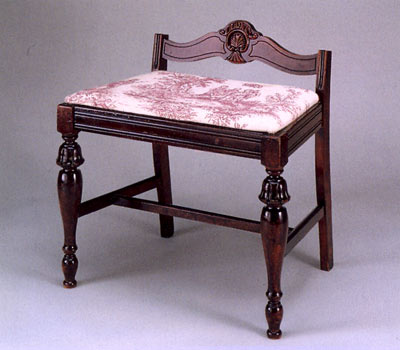 Home Work: Domestic Narratives in Contemporary Art
September 14 – November 3, 2012
Members preview reception: Thursday, September 13, 5:30 – 7:30pm
Green Hill Center
200 N Davie St
Greensboro, NC
Home Work: Domestic Narratives in Contemporary Art
September 14 – November 3, 2012
Members preview reception: Thursday, September 13, 5:30 – 7:30pm
Green Hill Center
200 N Davie St
Greensboro, NC
Interview with Occupy Museums, New York
New Full-Time Teaching Position at MICA
 I am very pleased to announce that I have accepted a position as a new member of the faculty at the Maryland Institute College of Art, where I will be joining the painting program.]]>
I am very pleased to announce that I have accepted a position as a new member of the faculty at the Maryland Institute College of Art, where I will be joining the painting program.]]>
A Cloak Over the Ocean @ BACK LANE WEST, Cornwall, England
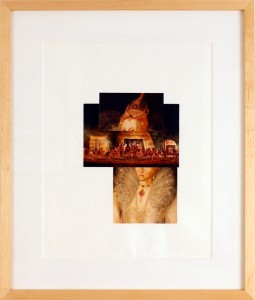 Solo Exhibition, Residency, and Artist Talk in Redruth, Cornwall, UK
JUNE 2012
American artist Lauren Frances Adams will be delivering an artist talk on June 9, 2012 at 7:00pm at Back Lane West concerning her research and creative enquiry on The Lost Colony Project, a series of artistic projects that for the past three years have utilized historical narratives and artistic conjecture to reveal ongoing modern thought about the era of Elizabethan colonialism.
During her time at Back Lane West in the southwest of England, the artist will be investigating Elizabethan-era stories relative to the region, such as the many colonial privateering ships that launched from or rounded the southwest of England, as well as the sites of connection between Cornwall and historical figures such as Sir Walter Ralegh, Sir Richard Grenville, and Sir Francis Drake. One figure in particular, British artist and colonist John White (1540 – 1593), who lived in Plymouth, made an extensive series of sensational watercolors which survive today in the British Museum’s collection and document the pre-colonial Algonquins of North America. White’s documentation has played a central role in The Lost Colony Project.
The Lost Colony Project concerns the first group of English settlers that disappeared from Roanoke Island in North Carolina in 1587. The colony was an enterprise organized by Sir Walter Raleigh, under the auspices of Queen Elizabeth I, to settle the coast of North America. At the core of the artist’s work is an awareness of the legacies of America’s origin stories and the purpose-driven narratives lending credence to colonial exploration and capitalist enterprise. Adams’ residency and exhibition at Back Lane West will investigate relationships between the role of historical narrative in the building of a sense of place and the contemporary intersections of colonialism, regional identity, and mythmaking.
A Cloak Over the Ocean at Back Lane West (which takes its title from an apocryphal story of Raleigh laying down his cape in a puddle for Queen Elizabeth), will ultimately be an artistic effort to negotiate the unstrung possibilities of the lack of linear storytelling and the exhaustion of grand narratives. Visualized through various strategies pointing back to the theatrical fragmentation and distorted lens of lost records, surreal tales, and archaic displays of political power, Adams’ work is an intensive program that seeks to manifest a network of historical loss.]]>
Solo Exhibition, Residency, and Artist Talk in Redruth, Cornwall, UK
JUNE 2012
American artist Lauren Frances Adams will be delivering an artist talk on June 9, 2012 at 7:00pm at Back Lane West concerning her research and creative enquiry on The Lost Colony Project, a series of artistic projects that for the past three years have utilized historical narratives and artistic conjecture to reveal ongoing modern thought about the era of Elizabethan colonialism.
During her time at Back Lane West in the southwest of England, the artist will be investigating Elizabethan-era stories relative to the region, such as the many colonial privateering ships that launched from or rounded the southwest of England, as well as the sites of connection between Cornwall and historical figures such as Sir Walter Ralegh, Sir Richard Grenville, and Sir Francis Drake. One figure in particular, British artist and colonist John White (1540 – 1593), who lived in Plymouth, made an extensive series of sensational watercolors which survive today in the British Museum’s collection and document the pre-colonial Algonquins of North America. White’s documentation has played a central role in The Lost Colony Project.
The Lost Colony Project concerns the first group of English settlers that disappeared from Roanoke Island in North Carolina in 1587. The colony was an enterprise organized by Sir Walter Raleigh, under the auspices of Queen Elizabeth I, to settle the coast of North America. At the core of the artist’s work is an awareness of the legacies of America’s origin stories and the purpose-driven narratives lending credence to colonial exploration and capitalist enterprise. Adams’ residency and exhibition at Back Lane West will investigate relationships between the role of historical narrative in the building of a sense of place and the contemporary intersections of colonialism, regional identity, and mythmaking.
A Cloak Over the Ocean at Back Lane West (which takes its title from an apocryphal story of Raleigh laying down his cape in a puddle for Queen Elizabeth), will ultimately be an artistic effort to negotiate the unstrung possibilities of the lack of linear storytelling and the exhaustion of grand narratives. Visualized through various strategies pointing back to the theatrical fragmentation and distorted lens of lost records, surreal tales, and archaic displays of political power, Adams’ work is an intensive program that seeks to manifest a network of historical loss.]]>
Nymans House and Gardens, National Trust, Sussex, UK
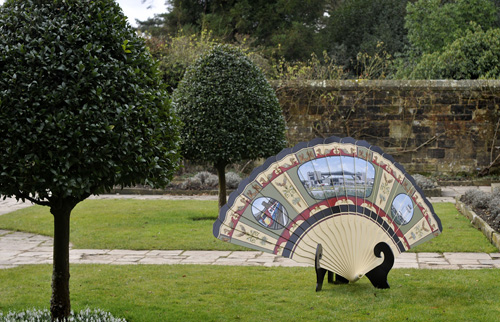 Upcoming site-specific commission for the Nymans House, owned by the National Trust, in Sussex, England (South of London).
‘The Grand Tour Fan,’ pictured here, appropriates from the original c. 18th century Grand Tour Fan on display in the Messel-Rosse fan collection at the Fitzwilliam Museum in Cambridge, UK.
The Messel-Rosse family lived at Nymans House in the 19/20th centuries and were avid decorative arts collectors.
Nymans House and Garden is a National Trust property known primarily for its exquisite English garden, which has been designed and developed by three generations of the Messel family. The artwork is a large-scale fan inspired by the Messel family fan collection. Grand Tour Fan appropriates from the original c. 18th century Grand Tour Fan on display in Cambridge. This fan inserts intentionally banal public places from contemporary Sussex life into the historical framework — substituting scenes of Italian ruins with those of Gatwick Airport (just a few miles from Nymans House).
Upcoming site-specific commission for the Nymans House, owned by the National Trust, in Sussex, England (South of London).
‘The Grand Tour Fan,’ pictured here, appropriates from the original c. 18th century Grand Tour Fan on display in the Messel-Rosse fan collection at the Fitzwilliam Museum in Cambridge, UK.
The Messel-Rosse family lived at Nymans House in the 19/20th centuries and were avid decorative arts collectors.
Nymans House and Garden is a National Trust property known primarily for its exquisite English garden, which has been designed and developed by three generations of the Messel family. The artwork is a large-scale fan inspired by the Messel family fan collection. Grand Tour Fan appropriates from the original c. 18th century Grand Tour Fan on display in Cambridge. This fan inserts intentionally banal public places from contemporary Sussex life into the historical framework — substituting scenes of Italian ruins with those of Gatwick Airport (just a few miles from Nymans House).
The second fan on display in the Nymans House and Gardens, Road to Nymans pictures the M23 roadway, the main thoroughfare between London and Nymans, which elevates with absurd revisions of the ornamental fan scenes, challenging site-specific concepts of fantasy and utopia.
Both fans will be placed on site for the ‘Unravelling the National Trust’ exhibition set to open May – November 2012. The fans are made of hand-painted CNC-milled sintra plastic with a wooden base. Photo credit: Sussie Ahlberg Special thanks to Noah Kirby, Doh Young Kim, Allison Gorman, and Jaidyn Seo for their assistance in digital file building and physical construction.]]>New Commission at Lambert St. Louis International Airport
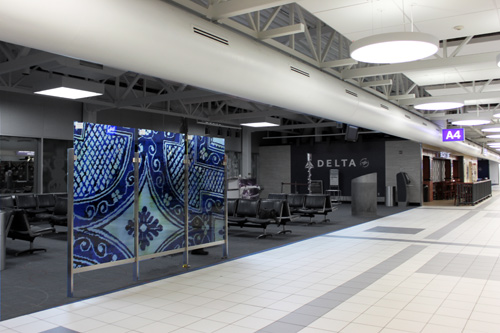 Untitled (Missouri Coverlet Abstraction 1850s to 2010)
Untitled (Missouri Coverlet Abstraction 1850s to 2010)
Permanently on view in Concourse A, Gate 4.
]]>Solo Exhibition in Seattle, WA
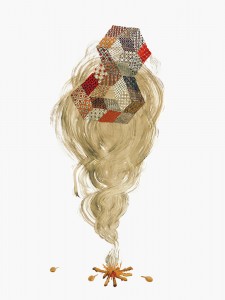 ‘Bear the Sway,’ a solo exhibition of new works on paper from The Lost Colony Project at South Seattle Community College in Seattle, Washington.
January 11 – February 17, 2012
Bear the Sway, a new body of work by Lauren Adams, relates to the artist’s recent investigations into the ‘Lost Colony’ and Elizabethan colonialism. This series of works on paper is inspired by the watercolors of John White from the 1580’s, which feature native Algonquins and Secotans (located then in present-day North Carolina) performing rituals, planting crops, preparing food, and displaying their clothing, and also the formal portraits of Queen Elizabeth I and the explorers and voyagers (Sir Walter Raleigh, Sir Francis Drake, etc.) who formed her colonial advisorship.
Bear the Sway is an exploratory series of paintings and drawings on paper and panel that lift, excise, and appropriate the found figures and clothing forms from the historical documents. The result is another facet of The Lost Colony Project, which visually collages the abstracted elements, creating charged absurdities that reflect the legacy of historical inequity in a contemporary visual language.
The basic tenet of this project is to resolve an understanding of the historical situations at work, and to interrogate the narratives and images, searching for a clearer display of the colonial power dynamics. Bear the Sway is also about the history of imagery as a site for political displays of power, which the artist utilizes as a directive when making her own imagery and objects. Seeking to transform the ‘given history’ into a new narrative, one that hopefully provides further agency to the appropriated narratives. In the The Lost Colony Project, the artist is exploring the relationship between costume, class, and social power.]]>
‘Bear the Sway,’ a solo exhibition of new works on paper from The Lost Colony Project at South Seattle Community College in Seattle, Washington.
January 11 – February 17, 2012
Bear the Sway, a new body of work by Lauren Adams, relates to the artist’s recent investigations into the ‘Lost Colony’ and Elizabethan colonialism. This series of works on paper is inspired by the watercolors of John White from the 1580’s, which feature native Algonquins and Secotans (located then in present-day North Carolina) performing rituals, planting crops, preparing food, and displaying their clothing, and also the formal portraits of Queen Elizabeth I and the explorers and voyagers (Sir Walter Raleigh, Sir Francis Drake, etc.) who formed her colonial advisorship.
Bear the Sway is an exploratory series of paintings and drawings on paper and panel that lift, excise, and appropriate the found figures and clothing forms from the historical documents. The result is another facet of The Lost Colony Project, which visually collages the abstracted elements, creating charged absurdities that reflect the legacy of historical inequity in a contemporary visual language.
The basic tenet of this project is to resolve an understanding of the historical situations at work, and to interrogate the narratives and images, searching for a clearer display of the colonial power dynamics. Bear the Sway is also about the history of imagery as a site for political displays of power, which the artist utilizes as a directive when making her own imagery and objects. Seeking to transform the ‘given history’ into a new narrative, one that hopefully provides further agency to the appropriated narratives. In the The Lost Colony Project, the artist is exploring the relationship between costume, class, and social power.]]>
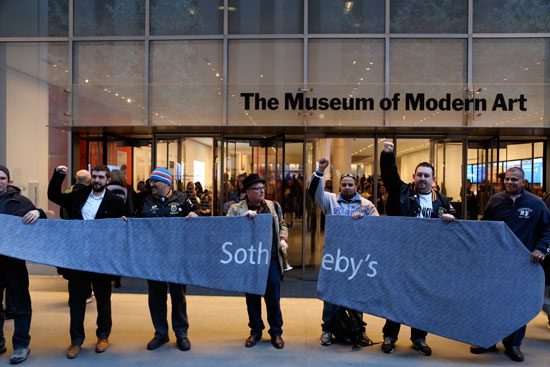 [/caption]
Published on Temporary Art Review,
[/caption]
Published on Temporary Art Review,